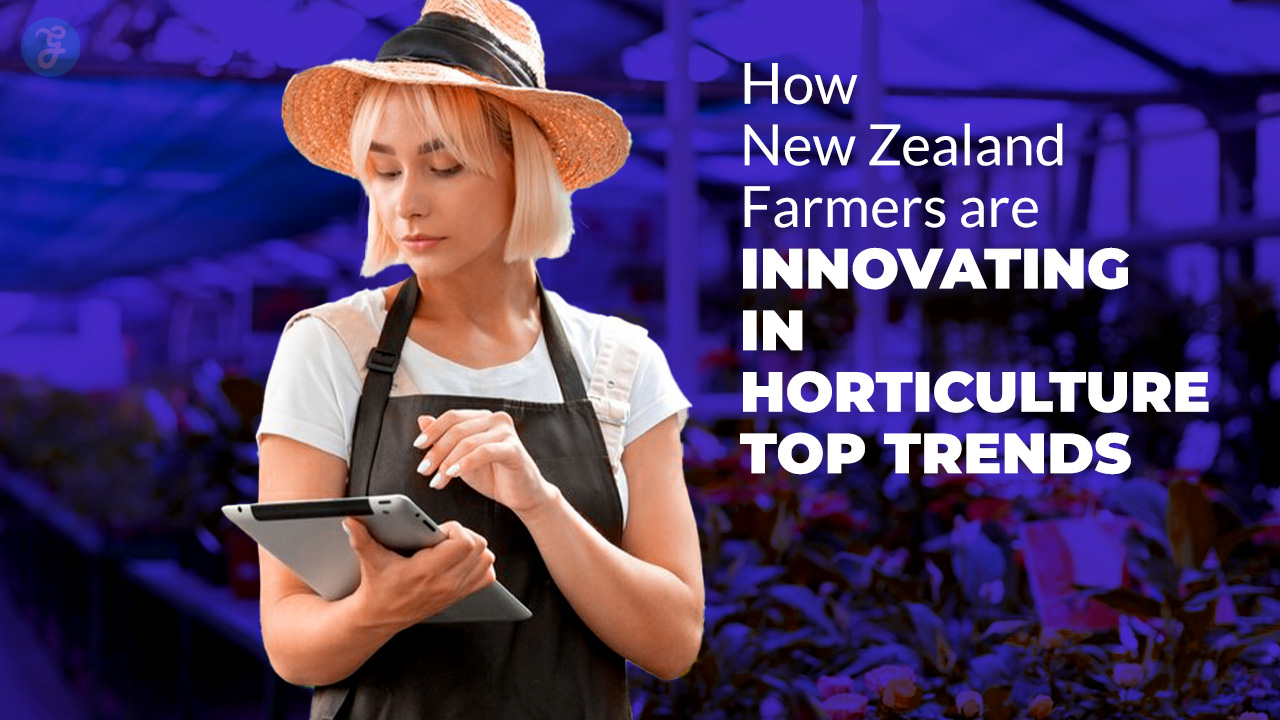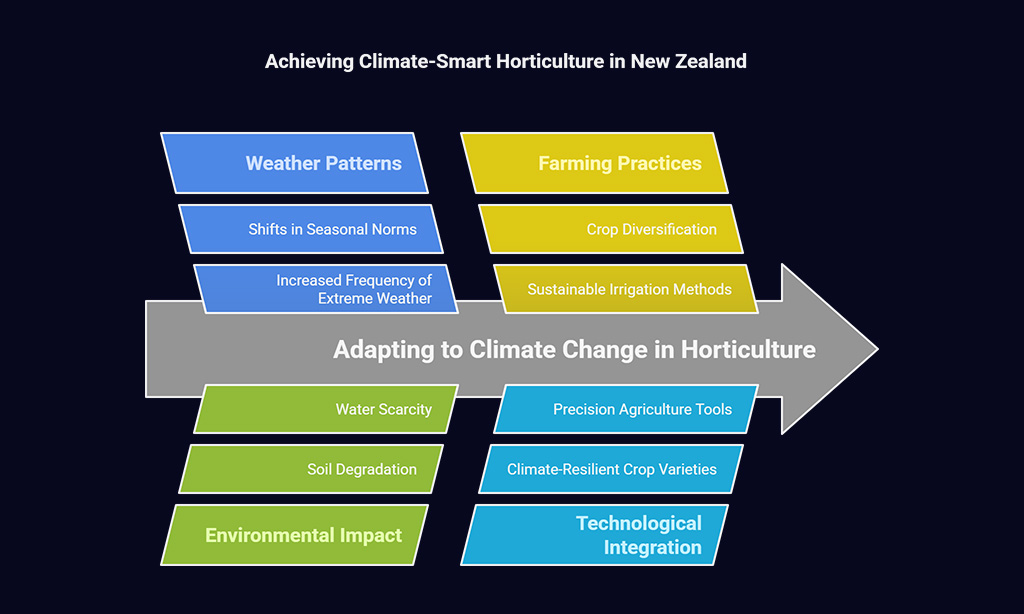New Zealand is renowned worldwide for its fertile landscapes and high-quality agricultural produce. The country’s horticultural sector, which is a cornerstone of its agricultural output, has seen remarkable innovations in recent years.
As farmers face new challenges such as climate change, labor shortages, and evolving market demands, they are increasingly turning to technology, sustainability, and new farming techniques to meet these challenges.
In 2025, New Zealand farmers are embracing innovative practices that not only drive economic growth but also ensure environmental sustainability. The horticulture industry is diversifying, becoming more data-driven, and incorporating automation to boost productivity while maintaining high standards of quality.
This article explores the top 10 trends that are shaping New Zealand’s horticulture in 2025 and how these trends are revolutionizing farming practices across the country.
Why Innovation is Key for New Zealand Farmers?
As one of the world’s leading exporters of fresh produce, New Zealand farmers face growing demands for more efficient and sustainable farming practices. Factors such as fluctuating global food prices, the need for environmental conservation, and labor shortages have compelled farmers to embrace innovative methods.
These challenges, while significant, offer New Zealand’s horticultural sector a chance to transform the way farming is done—allowing it to become more resilient, productive, and sustainable in the long run.
Top 10 Trends Shaping Horticulture in New Zealand for 2025
Let’s take a look.
Trend 1: Embracing Smart Farming Technologies
Smart farming technologies are revolutionizing the way New Zealand farmers manage their operations. These technologies allow for more precise farming practices, leading to better resource management and increased efficiency.
The use of drones, sensors, and AI systems are all integral parts of this technological shift.
Precision Agriculture and Data-Driven Decisions
Farmers are increasingly utilizing precision agriculture, which uses data collected from sensors and satellites to make decisions about planting, irrigation, and fertilization. With data analytics tools, farmers can assess soil moisture, crop health, and nutrient levels, helping them make more informed decisions that minimize waste and maximize yields.
By using data to optimize resource allocation, New Zealand farmers can reduce operational costs while maintaining high productivity.
Drones and IoT in Horticulture
Drones and IoT devices are being widely adopted to monitor crops and collect real-time data. Drones can perform aerial surveillance, taking images of crops to detect signs of disease or pest infestations. IoT sensors embedded in the soil provide valuable data on temperature, moisture, and other conditions that affect plant growth. This combination of technologies allows farmers to address issues quickly and make more precise, informed decisions about their crops.
| Technology | Application | Benefits |
| Precision Agriculture | Use of data and sensors for field analysis | Optimized irrigation, fertilization, and pest management |
| Drones | Aerial imagery for crop surveillance | Early detection of pests, diseases, and growth issues |
| IoT | Sensors that monitor soil and environmental conditions | Real-time data collection for better farming decisions |
Trend 2: Sustainable Farming Practices
Sustainability in agriculture has moved from a buzzword to a necessity, and New Zealand is leading the way. Sustainable farming practices not only benefit the environment but also ensure long-term profitability by reducing reliance on costly inputs and preserving soil health.
Regenerative Agriculture Techniques
Regenerative agriculture focuses on restoring and improving soil health through natural processes. This approach emphasizes practices such as crop rotation, cover cropping, and reduced tillage to enhance soil biodiversity and carbon sequestration. In New Zealand, farmers are adopting regenerative practices to not only restore depleted soils but also increase their resilience to extreme weather events, such as droughts or floods.
Reducing Carbon Footprints in Horticultural Operations
New Zealand farmers are increasingly adopting practices to reduce their carbon footprints, with a focus on renewable energy, reduced chemical usage, and water conservation. The shift toward organic farming and the use of biofertilizers are just a few examples of how New Zealand farmers are minimizing their environmental impact. For example, many farms are now installing solar panels to power irrigation systems or using wind energy to run greenhouses.
| Sustainable Practice | Description | Benefits |
| Crop Rotation | Planting different crops in the same field in successive seasons | Reduces soil depletion and pest build-up |
| Reduced Tillage | Minimizing soil disturbance to enhance soil structure | Improves water retention and reduces erosion |
| Organic Fertilizers | Using natural substances to fertilize crops | Decreases reliance on chemical fertilizers and reduces pollution |
Trend 3: Automation in Horticulture
As labor shortages continue to impact farming, automation is becoming increasingly essential in New Zealand’s horticulture sector. Farmers are adopting robotic systems to streamline operations, improve efficiency, and reduce costs.
Robotic Harvesting and Picking Systems
Robotic harvesting systems, especially those designed for fruits like apples, kiwifruit, and berries, are changing how produce is harvested. These robots can work faster and more efficiently than human laborers, ensuring that crops are picked at the optimal time for quality and taste. This not only saves time and labor costs but also reduces the risk of human error.
Labor Efficiency and Cost Reduction
Automated systems are also helping farmers tackle labor shortages. These systems perform repetitive tasks, such as pruning, weeding, and harvesting, allowing farm workers to focus on more skilled tasks. The efficiency gains from automation also help reduce operational costs, allowing farmers to reinvest in their businesses and explore more innovative practices.
| Automation Application | Description | Benefits |
| Robotic Harvesting | Robots that pick fruits or vegetables | Reduces labor costs and increases harvesting efficiency |
| Automated Irrigation Systems | AI-powered irrigation that adjusts water usage | Reduces water wastage and optimizes water usage |
| Autonomous Tractors | Tractors that operate without human drivers | Improves operational efficiency and reduces fuel consumption |
Trend 4: Vertical Farming and Hydroponics
As urbanization increases, so does the need for efficient food production within cities. Vertical farming and hydroponics offer solutions for growing crops in urban areas with limited space.
Urban Agriculture and Space Optimization
Vertical farming involves growing crops in stacked layers, often using hydroponic or aeroponic systems. This method allows farmers to grow food in urban environments where land is scarce and costly. By using artificial lighting and controlled environments, vertical farms can produce high yields of vegetables, herbs, and leafy greens throughout the year, regardless of weather conditions.
The Future of Localized Food Production
Hydroponic farming, where plants grow in nutrient-rich water instead of soil, is another innovative solution that New Zealand farmers are adopting. This method uses up to 90% less water than traditional farming and allows crops to grow faster due to optimized nutrient delivery. Hydroponics is especially suited for growing high-demand crops like lettuce, spinach, and herbs in urban areas.
| Farming Method | Description | Benefits |
| Vertical Farming | Crops grown in stacked layers in controlled environments | Maximizes space, reduces transportation costs |
| Hydroponics | Growing crops in water-based nutrient solutions | Water-efficient, faster crop growth, ideal for urban areas |
Trend 5: Crop Diversification and Specialty Crops
To ensure greater resilience to market fluctuations and environmental changes, New Zealand farmers are diversifying the crops they grow. This helps mitigate the risks associated with mono-cropping and allows farmers to tap into niche markets.
Expanding Beyond Traditional Crops
While New Zealand is known for its production of apples, grapes, and kiwifruits, many farmers are now exploring the potential of growing less conventional crops like herbs, edible flowers, and exotic fruits. This diversification enables farmers to capture the interest of consumers who are increasingly looking for unique, health-conscious food options.
New Varieties for Changing Consumer Preferences
Consumers are becoming more health-conscious, and New Zealand farmers are responding by growing more nutrient-dense crops. Superfoods like avocados, berries, and mushrooms are gaining popularity, and farmers are adjusting their crop portfolios to meet this demand. Additionally, climate change is creating new opportunities for growing crops that were previously unsuitable for New Zealand’s climate.
| Diversified Crop | Description | Benefits |
| Edible Flowers | Growing flowers that are safe to eat, such as nasturtiums or pansies | Adds variety and appeal to meals, can be used for garnishing |
| Superfoods | Crops like blueberries, kale, and avocados | High market demand for healthy food, adds value to farm output |
| Exotic Fruits | Growing tropical fruits like dragonfruit or passionfruit | Expands the product range and attracts new customers |
Trend 6: Focus on Soil Health and Fertility
Soil health is the cornerstone of productive farming. New Zealand farmers are increasingly focusing on soil health management practices to enhance crop yields and sustainability.
Innovative Soil Management Techniques
New Zealand farmers are investing in precision soil management to optimize the soil’s fertility and structure. Technologies such as soil sensors and digital mapping tools allow farmers to monitor soil conditions more effectively and tailor their farming practices to the specific needs of their crops. This approach helps reduce overuse of fertilizers and ensures that crops receive the right nutrients at the right time.
The Role of Biofertilizers and Soil Microbes
Farmers are also turning to biofertilizers and soil microbes to improve soil health. These natural solutions help promote the growth of beneficial microorganisms in the soil, which in turn improve nutrient availability, water retention, and soil structure. Biofertilizers are seen as a sustainable alternative to synthetic chemical fertilizers.
| Soil Health Practice | Description | Benefits |
| Precision Soil Management | Monitoring and adjusting soil conditions using technology | Improves soil fertility and optimizes resource use |
| Biofertilizers | Natural fertilizers that promote healthy soil microorganisms | Reduces the need for synthetic fertilizers and improves sustainability |
Trend 7: Climate-Smart Horticulture
With climate change impacting global agriculture, New Zealand’s horticultural sector is placing a significant emphasis on climate-smart farming practices. These practices aim to increase resilience to changing weather patterns and reduce the environmental impact of farming activities.
Adapting to Extreme Weather Events
Climate-smart horticulture involves adapting farming practices to address challenges posed by unpredictable weather patterns, such as intense droughts or heavy rainfall.
For example, New Zealand farmers are incorporating drought-resistant crop varieties, modifying irrigation techniques, and investing in better water storage systems. They are also implementing soil conservation strategies to prevent erosion during heavy rainfall, ensuring long-term land productivity and sustainability.
Diversification of Crops to Mitigate Risk
By diversifying the crops they grow, New Zealand farmers are mitigating the risk of crop failure due to extreme weather. For example, some farmers are adopting crops that are more resistant to heat or cold.
Others are adjusting planting seasons based on long-term weather forecasts to avoid periods of drought or excessive moisture. These adaptive strategies make farms more resilient to climate extremes, reducing the financial risk for farmers.
| Climate-Smart Practice | Description | Benefits |
| Drought-Resistant Varieties | Growing crops that are more resilient to heat and water scarcity | Reduces water usage and ensures harvests in dry conditions |
| Soil Conservation | Using techniques like cover cropping and no-till farming to reduce erosion | Protects soil health, especially in flood-prone regions |
| Adjusting Planting Seasons | Shifting planting dates to avoid adverse weather | Helps avoid crop losses due to sudden temperature shifts or heavy rainfall |
Trend 8: Farm-to-Table and Direct-to-Consumer Models
With growing consumer demand for locally sourced, fresh, and sustainably grown produce, New Zealand farmers are embracing direct-to-consumer sales channels. The farm-to-table model ensures fresh produce reaches consumers faster while reducing the carbon footprint of transportation.
Direct Marketing and E-Commerce Platforms
Farmers are increasingly selling their produce directly to consumers through farmer’s markets, community-supported agriculture (CSA) programs, and online platforms.
E-commerce allows farmers to reach a wider audience and build a loyal customer base. Some farmers are even utilizing subscription models, where consumers can receive weekly deliveries of fresh produce directly from the farm.
Building Relationships with Consumers
Farm-to-table initiatives help strengthen the relationship between farmers and consumers. By offering transparency into how food is produced, farmers can build trust with their customers, particularly those concerned about the environmental and ethical practices of food production. This connection helps farmers achieve higher prices for their products by emphasizing quality, sustainability, and traceability.
| Sales Model | Description | Benefits |
| Direct-to-Consumer (DTC) Sales | Selling products directly to customers via online platforms or local markets | Increases farmer profits, reduces middlemen costs |
| Community-Supported Agriculture (CSA) | Consumers subscribe to receive regular deliveries of fresh produce | Builds consumer loyalty and ensures steady income for farmers |
Trend 9: The Rise of Plant-Based and Alternative Protein Crops
As the global food system shifts towards plant-based diets and sustainable protein sources, New Zealand farmers are increasingly exploring the cultivation of plant-based proteins and other alternative food sources.
Growing Demand for Plant-Based Foods
The rise of plant-based diets has driven demand for plant-based proteins, such as legumes (e.g., peas, lentils) and other alternative protein crops like quinoa, hemp, and soy. New Zealand farmers are expanding their crop selection to include these high-protein, low-impact foods, which are increasingly popular due to health, environmental, and ethical considerations.
For example, hemp farming has surged in New Zealand, as it provides both protein-rich seeds and fibers for use in various industries, from food to textiles.
Research into New Protein Crops
Farmers are also investing in research to develop new types of protein-rich crops that can serve as alternatives to meat. Crops like mung beans, chickpeas, and algae are gaining attention for their high protein content and minimal environmental impact. New Zealand’s investment in agricultural research and innovation has made it a hub for discovering viable crops that can meet the growing demand for sustainable, plant-based protein sources.
| Alternative Protein Crop | Description | Benefits |
| Legumes (Peas, Lentils) | Protein-rich crops with low environmental impact | Provides sustainable protein, enriches soil nitrogen |
| Hemp | Versatile crop with edible seeds and fiber | High-protein food source and eco-friendly material |
| Algae (e.g., Spirulina) | Protein-rich microorganisms used for food and supplements | Nutrient-dense, highly sustainable, grows in minimal space |
Trend 10: Integrated Pest Management (IPM) and Biocontrols
Sustainable pest control is a critical concern for New Zealand’s horticulture sector, especially as consumers demand pesticide-free produce. Integrated Pest Management (IPM) and biocontrols are becoming essential tools in sustainable farming practices.
Harnessing Nature to Control Pests
Biocontrols use natural predators, parasites, or pathogens to manage pest populations. For example, New Zealand farmers have introduced beneficial insects, such as ladybugs, to control aphid infestations.
Additionally, microbial pesticides are being used to target specific pests without harming beneficial organisms. These biocontrol methods offer an effective, sustainable alternative to chemical pesticides, ensuring that crops remain healthy without damaging the environment.
Reducing Pesticide Use Through IPM
Integrated Pest Management combines a variety of pest control methods, such as biological control, crop rotation, and habitat manipulation, to manage pest populations in an environmentally responsible manner.
This strategy aims to reduce the reliance on chemical pesticides while maintaining effective pest control. New Zealand farmers are increasingly adopting IPM as a way to protect both crops and the environment while meeting the growing demand for pesticide-free produce.
| Pest Management Method | Description | Benefits |
| Biocontrols | Using natural enemies (predators, parasites) to control pests | Reduces chemical pesticide use, environmentally friendly |
| IPM (Integrated Pest Management) | Combining biological, cultural, and mechanical pest control methods | Effective pest control, minimizes environmental impact |
Wrap Up
The horticultural sector in New Zealand is undergoing a remarkable transformation in 2025, driven by innovation, sustainability, and technology. From smart farming techniques to climate-smart practices and automation, New Zealand farmers are leveraging cutting-edge technologies to ensure the future of their industry.
These trends not only help increase productivity and profitability but also contribute to a more sustainable and resilient agricultural system that benefits both farmers and the environment.
As the world faces more challenges related to climate change, resource scarcity, and shifting consumer preferences, New Zealand farmers are well-positioned to continue leading the charge in horticultural innovation.
By embracing new farming techniques, focusing on sustainability, and responding to market demands, New Zealand farmers are proving that innovation in horticulture is not just a trend—it’s the future.
The continued adoption of these trends will ensure that New Zealand’s horticultural industry remains competitive, resilient, and environmentally conscious, creating a model for global farming practices in the years to come.












































